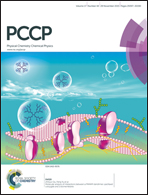Formation of Li3O4 nano particles in the discharge products of non-aqueous lithium–oxygen batteries leads to lower charge overvoltage†
Abstract
Density functional theory calculations are made for bulk thermodynamic properties and surface energies of Li2O2, a primary discharge product, and Li3O4, a possible byproduct in the discharge products, of the non-aqueous lithium–oxygen batteries. Results show that the standard formation Gibbs free energy of bulk Li3O4 is marginally higher than that of Li2O2, but the surface energy of Li3O4 is much lower. Low surface energy results in both lowered nucleation energy and formation Gibbs free energy in the nanometer regime, allowing the Li3O4 nano particles to nucleate ahead of Li2O2 during the discharge process and to exist stably when particle sizes are smaller than about 40 nm. The scanning transmission electron microscopy (STEM) image of Li3O4 crystals is simulated and compared with the measured STEM image of the discharge product particles. The consistency between the simulated and measured STEM images suggests that the Li3O4 phase can exist stably as a discharge product. The energy profile of the oxygen evolution reaction (OER) occurring on the most abundant surfaces of Li3O4 is also calculated. The predicted overpotential for the OER on the {0001} surface (0.30 V) shows a good agreement with experimental data. The presence of more electronically conductive Li3O4 nano particles in the primary discharge product Li2O2 tends to decrease the charge overvoltage of the batteries, explaining why the lower voltage area (<3.5 V) was widely observed during the charging of the batteries. An increase in the oxygen pressure or a decrease in temperature enhances the stability of the Li3O4 phase and increase the proportion of the Li3O4 phase in the discharge products, consequently leading to a lower overall charge overvoltage.



 Please wait while we load your content...
Please wait while we load your content...